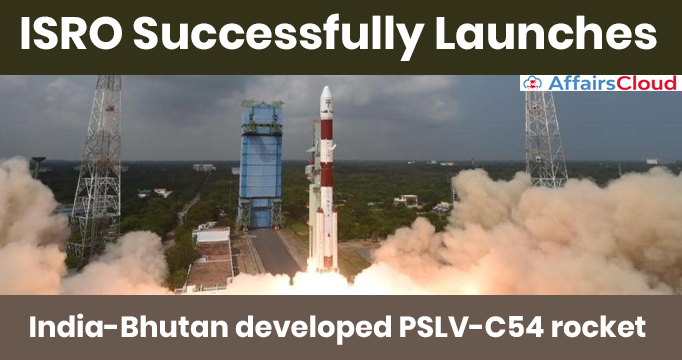 On November 26, 2022, the Indian Space Research Organization (ISRO) successfully launched the Polar Satellite Launch Vehicle (PSLV)-C54 rocket from First Launch Pad (FLP) Satish Dhawan Space Centre in Sriharikota, Andhra Pradesh (AP).
On November 26, 2022, the Indian Space Research Organization (ISRO) successfully launched the Polar Satellite Launch Vehicle (PSLV)-C54 rocket from First Launch Pad (FLP) Satish Dhawan Space Centre in Sriharikota, Andhra Pradesh (AP).
- This is the 56th flight of PSLV, and the 24th Flight of the PSLV-XL version with 6 PSOM-XLs.
Satellites carried by PSLV-C54 rocket:
It carried 9 satellites viz. India’s Earth Observation Satellite -06 (EOS-06), also known as Oceansat-3, and the 8 nanosatellites viz. ISRO Nano Satellite-2 for Bhutan (INS-2B), Anand Satellite, 4 Astrocast satellites, and 2 Thybolt satellites.
About Satellites:
EOS-06
Weighing 1,117 kgs, it is built by ISRO for use by departments and ministries in the Government of India. It is third generation satellite in the Oceansat series, which provides continued services of Oceansat-2 with enhanced payload capability.
- It carried four payloads viz. Ocean Color Monitor (OCM-3), Sea Surface Temperature Monitor (SSTM), Ku-Band Scatterometer (SCAT-3), ARGOS.
INS-2B
Weighing 18.28 kgs, India-Bhutan SAT will provide high-resolution images to Bhutan for the management of its natural resources. It is a collaborative mission between India and Bhutan. It has the following two payloads:
- NanoMx, a multispectral optical imaging payload developed by Space Applications Centre (SAC)
- APRS-Digipeater, which is jointly developed by DITT (Department of Information Technology & Telecom)-Bhutan and U R Rao Satellite Centre (URSC), Bengaluru (Karnataka).
Anand:
Weighing 16.51 kgs Satellite, Anand is developed by India’s Bengaluru (Karnataka)-based startup Pixxel. It is a three axis stabilized nano satellite which act as technology demonstrator for miniaturized electro-optical payload.
Thybolt:
Weighing around 1.45 kgs, it is 0.5U spacecraft bus with 2 two Satellites from Dhruvaspace, India. It includes a communication payload to enable rapid technology demonstration and constellation development for multiple users
Astrocast:
Weighing 17.92kg, it is a 3U spacecraft with 4 Satellites from Spaceflight Inc, US (United States). They were a technology demonstrator for the Internet of Things (IoT) as the payload.
Key Points:
i.India has assisted in building up the capacity of Bhutanese engineers through hands-on training at the UR Rao Satellite Centre (URSC) in Bengaluru.
ii.ISRO is planning to have its mission to the sun with its satellite Aditya-L1, a coronagraphy spacecraft to study the solar atmosphere, with a PSLV rocket in 2023.
Recent Related News:
i.NewSpace India Limited (NSIL), a CPSE (Central Public Sector Enterprises) under the Department of Space (DoS) and the commercial arm of ISRO, signed two launch service contracts with M/s Network Access Associated Limited (M/s OneWeb), United Kingdom, for launching OneWeb LEO Broadband.
ii.ISRO has named Dr. Sankarasubramanian K, a senior solar scientist at URSC, Bengaluru, Karnataka, as the Principal Scientist of Aditya-L1 mission.
About Indian Space Research Organisation (ISRO):
Chairman– S. Somanath
Headquarters– Bengaluru, Karnataka
Establishment– 1969




